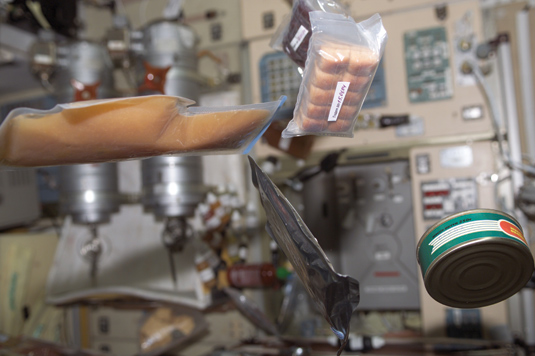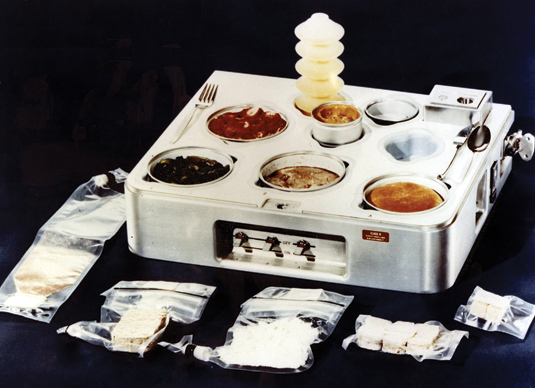| |
Meatpaper six
Spam in a Can
A brief history of meat in orbit
story by Nicholas de MoNchaux
December, 2008
 fig 1: Food packets with Russian canned tuna, snapped by ISS
Science Officer Ed Lu, NASA Images ISS007-E-06702 (8 June
2003) fig 1: Food packets with Russian canned tuna, snapped by ISS
Science Officer Ed Lu, NASA Images ISS007-E-06702 (8 June
2003)
WHEN THE MERCURY ASTRONAUTS went
into space, strapped down in capsules set atop primitive
ICBMs originally designed to carry warheads, they were famously
derided by their fellow test pilots as “SPAM in a Can.”1
Today, SPAM’s legacy as a term for junk mail drowns out any other association, but in the case of the astronauts, we are talking about ur-Spam, the meat product squeezed into a can — a name provided by the winner of a write-in contest, Kenneth Gaidneau (who had considered it “a good, memorable trade-name for some time, [and] had only waited for a product to attach it to”2).
Much like their namesake processed
pork product — the Mercury astronauts were mere passengers
in their steel capsule, with no control over its historic
trajectory.
John Glenn and his fellow Mercury astronauts were squeezed into a metal enclosure only slightly bigger than themselves — half the size, for comparison, of a contemporaneous VW beetle. But tight quarters — common for test pilots in prototype craft — were not the catalyst for the Spam-in-a-can taunt. Rather, the Mercury crew members were mocked by their brethren (Chuck Yeager is said to have coined the phrase) for their relative impotence. Unlike more earthly pilots — but, presumably, much like their namesake processed pork product — the Mercury astronauts were mere passengers in their steel capsule, with no control over its historic trajectory.
While some had reservations about whether pilots would be able to function under the firsthand experience of outer space (doctors had explicitly predicted “a very severe sensation of succumbence associated with an absolute incapacity to act”3), the lack of control afforded to Mercury pilots over their craft was chiefly a result of the capsule’s history. The Mercury capsule was rapidly adapted from the nuclear warheads that it replaced on the head of Redstone and Atlas rockets, which were designed to be controlled from the ground by the Air Force’s Strategic Air Command. (The Redstone, specifically, was a direct ancestor of the V-2 rockets rained by Von Braun and Hitler on London 15 years earlier; like the V-2, it retained a portable firing structure, or Abschussplattform, that had allowed the German missile to be launched alfresco from forests and city neighborhoods, obscuring launch sites from the Allies). A warhead had no need for its own steering wheel, and was controlled from the ground, as were the Mercury capsules from Cape Canaveral, then Houston, where NASA moved its manned space flight facilities in 1963.
On board the Mercury, the food for the astronauts was possibly even less palatable than the prospect of traveling into space as tinned meat. NASA itself characterized the astronauts’ culinary experience as “a testament to [their] fortitude.” Astronauts consumed anonymous gelatin-coated cubes and pastes from tubes.
Little culinary progress had been made by the time of the later Gemini missions. Like the Mercury astronauts before them, the two-man Gemini crews ate chiefly pastes from tubes, although theirs could be rehydrated by injecting water recycled from the craft’s fuel cells.
The same system made its way into Apollo, where the astronauts of Apollo 10 found their two-week translunar trajectory marred chiefly by the amount of nitrogen gas that made its way into the fuel cell water, and thus the crew’s rehydrated food. By the end of the two-week journey, the atmosphere of their command module was “made of farts.” Secondary were complaints about the food’s actual quality. The sausage patties served to the astronauts “tasted like granulated rubber and left an unpleasant taste.”

fig 2: Heated Skylab serving tray (note steak), NASA Image
NAS9-9-60169-164016
As of 1968, when its giant L1 rocket (competitor
of the giant SaturnV rocket that launched Apollo to the moon)
failed repeatedly, the Soviet Union gave up competing with
the United States on distance, and instead embarked on feats
of orbital endurance, launching the first Salyut space station
in 1971. Then, in the last and most blatantly contrived of
1970s space exploits, a final Apollo capsule docked with
its Soviet counterpart for the Apollo-Soyuz Test Project
of 1975. The Soviet and American crews shared food, including
Russian treats (caviar and paté) that took well to canning.
And, while no alcohol has been served in space, vodka labels
were attached to several tubes of Russian beef paste for
use in toasting during the orbit’s diplomatic events.
While
the American Apollo astronauts of ASTP were unable to offer
their Soviet counterparts food nearly as memorable as vodka-themed
beef, their colleagues aboard the U.S. Skylab space station
— launched to compete with the Soviets’ Salyut station in
1973 — had some of the most refined offerings ever served
in orbit. As if recalling Nixon’s famous 1959 Kitchen Debate
with Khruschev, Skylab astronauts not only consumed the closest
thing to Earth food served before (or since) in space, but
did so in a setting that included a dining table, heated
trays, a refrigerator, and a freezer in a fashionable avocado
hue.
The Soviet–American space-food
disparity appears in film as well. In Kubrick’s 2001, the
auteur hired Frederick Ordway III (who had been Von Braun’s
lieutenant at NASA’s Marshall Spaceflight Center) to ensure
technological veracity as he crafted an essay on the alienation
(and resulting “space-child” evolution) of Homo sapiens.
In the 1968 film, five minutes of screen time are given to NASA administrator Heywood Floyd’s silent meal on a moon-bound Pan Am starship. Kubrick’s camera lingers as Floyd sucks denatured fish, corn, and coffee from pouches in a cardboard tray. Four years later, Andrei Tarkovsky staged the dramatic crux to his Solyaris — a Soviet riposte to 2001 — in an ornate dining room in the Solaris station’s core, where scientist Kris Kelvin talks with his colleagues and a vision of his dead wife, Hari (apparently conjured by the alien planet below), over a carved roast.
Since the suburban glory of Skylab’s dining room, space food has taken a turn back toward the denatured. As ever, meat occupies a central place at the astronauts’ table, where heavily sauced beef and chicken are favored for their ability to stay in single, spherical blobs if “spilled.”
But cans are making a comeback. The U.S. space shuttle is scheduled to retire in 2010. In the meantime, the giant cargo bay of the United States’ only space vessel will be used almost exclusively to haul pieces of the space station, meaning that the task of supplying the station with food and other more day-to-day provisions is falling to Russia.
And, since the 1970s, the enduringly practical
Russian system has focused less on re-creating an earthbound
dining experience, or creating space food de novo, than on
convenience. The canned space food product Tushenka, in particular,
is said to taste a lot like Spam. 
NICHOLAS DE MONCHAUX is an architect, urbanist, and critic. Currently Assistant Professor of Architecture at UC Berkeley, his creative work and writing has been published in the New York Times, the New York Times Magazine, and Meatpaper Issue Zero. His forthcoming book on the shared history of the Apollo extravehicular garment and 20th-century urban design practice, Spacesuit: 21 Essays on Nature, Technology, and Design, will be published in 2009 by Princeton Architectural Press.
NOTES
1. Wolfe, Tom, The Right Stuff (New York: Farrar, Straus, and Giroux,
1983), p. 33.
2. Oxford English Dictionary, Second Edition (New York: Oxford
University Press, 1989).
3. Otto Gauer and Heinz Haber in “Man under Gravity-Free Conditions”
(German Aviation Medicine, World War II, I, 641-643), quoted
in Loyd S. Swenson, James M. Grimwood, Charles C. Alexander, This
New Ocean: A History of Project Mercury (Washington, DC, NASA
Scientific and Technical Information Division: 1966), p. 36.
This article originally appeared in
Meatpaper Issue Six.

|
|
